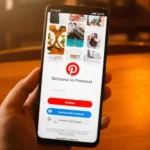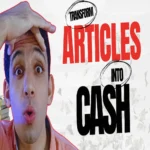If you’ve ever wondered “What’s in his stack?” — I’ve shared it all in one place.
👉 See my best picks
Imagine you pour your heart, nights, weekends into your first digital product. The scribbled outlines, the caffeine-fueled design sessions, the obsessive tweaking of every sentence — it’s all done. You hit “publish.” You wait for the cha-ching notification…
…crickets.
That was me. My first eBook — “How to Make Money Online” — launched with zero momentum. Not even my closest friends bought it. I sat and refreshed my dashboard daily, hoping for a surprise. Nothing. Silence.
That failure burned something into me: nobody buys eBooks. They buy change. They buy a result. A promise. A transformation. Once I understood that, I repackaged, rethought, repositioned — and sales began to flow.
So: this isn’t about creating content — it’s about creating results. And then wrapping those results in irresistible packaging. Let me show you how.
👉Enjoy reading:17 Real Things to Sell on Etsy That Actually Make Money (No Craft Degree Required)
The Mindset Shift: Sell Transformation, Not Info
We live in an oversaturated world of “how to’s.” Google offers 100 tutorials in seconds. But what people truly pay for is escape from confusion, clarity, speed. They want to feel something.
So every time you plan a product, start with this fill-in-the-blank:
“After using this product, my customer will ______.”
If you can’t fill that in with something vivid and emotional — “feel confident,” “launch a business in 30 days,” “never waste time again” — you’re missing the core.
Because while content is everywhere, strategy + positioning + emotional promise is rare. That’s what commands attention and trust.
Which Format Works Best? (E-books, Templates, or Courses)
You might think: “Course = more income.” But that’s not always true. Choose your format based on what your audience needs, and what you can deliver well.
| Format | Ideal For… | Pros & Cons |
|---|---|---|
| E-Books | Teaching ideas, frameworks, step-by-step guides | Easy to create, low bar to entry — but harder to stand out |
| Templates | Saving time, giving structure (Notion, spreadsheets, design kits) | High perceived value, quick to deliver — but buyers want previews & proof |
| Courses | Deep, guided transformation (skill-based, multi-step) | Higher earning potential and authority — but heavier lift, quality demands |
Here’s my personal shift: my first eBook died. Then I turned it into a mini course + workbook — it sold 5× more. Because structure, hand-holding, and clarity beat raw content every time.
So start with templates or guides. Then let your customers beg you to turn it into a course.
Packaging That Sells — Because Looks Do Matter
You can’t launch something that looks amateur and expect people to trust it. Even the greatest content can fall flat with weak presentation.
Here’s how to make your product irresistibly premium:
- Mockups & visuals: Use tools like Canva or SmartMockups to show your eBook on devices, templates in action. Visualize the result.
- Design + layout: Even simple styling — consistent fonts, whitespace, nice colors — elevates trust.
- Benefit-focused titles: Instead of “Freelancing Guide,” try “The Freelance Freedom Roadmap: Earn $1,000 Your First Month.”
- Emotional cues & brand voice: Use relatable language, stories, or pain-to-pleasure arcs.
- Bonuses: Add checklists, cheatsheets, templates — little things that feel like gifts increase conversions.
The goal: the moment someone lands on your sales page, they “feel” the value — before even reading.
👉Worth Checking: AI for Digital Products: 15 Free Tools for Creators
Pricing Psychology — Don’t Undervalue Yourself
Here’s the paradox: price too low → people doubt quality. Price too high → your ideal beginners balk.
Here’s a structure that works:
- Tiered pricing
- Basic: eBook
- Standard: eBook + templates
- Premium: eBook + templates + mini-course or coaching
People often choose the middle tier because it feels “safe but upgraded.”
- Bonuses & scarcity
- “First 20 buyers get bonus workbook”
- “48-hour launch price”
These small nudges push fence-sitters to choose now, not later.
- Test your pricing
Start at a price you feel good about. As you accumulate proof & testimonials, bump up. Always align price with perceived transformation. - Emotion > math
Customers don’t buy what you think it’s worth. They buy how badly they want their problem solved.
Smart Selling: Where & How to Convert
You don’t need a perfect website or a fully built funnel to start. Use platforms that handle the tech so you can focus on messaging and promotion.
Platforms to use first:
- Gumroad
- Payhip
- Stan Store
- Etsy (for templates)
They manage payment, digital delivery, and refunds, so you can focus on your offer.
Promotion strategy (without sounding “salesy”):
- Tell stories, not product pitches
Show your process: “I built this template after organizing five years of notes…”
Humans connect to stories — not product specs. - Build anticipation
Share behind-the-scenes: “Designing the workbook tonight,” “Which bonus would you prefer — checklist or swipe file?”
This primes your audience. - Use social proof
Once you make a few sales or get comments: screenshot, share, and highlight how your product is helping people. - Limited-time offers
Use deadlines, bonus thresholds, early-bird pricing — the fear of missing out (FOMO) moves people to act. - Conversion boosters
- Compelling CTAs: “Start your journey,” “Grab instant access”
- Previews or sample pages
- “Instant access,” “Download now” cues
- Before/after visuals or mini case studies
Every little detail compounds trust and persuasion.
The Beauty of Digital Products: Create Once, Sell Forever
Here’s the magic: you build once, you sell forever.
Your first launch might bring a trickle of sales. Launch again. Grow your library. Cross-promote. Bundle. Reuse. Your digital shelf becomes your silent sales team while you sleep.
But here’s a frank truth: if you wait until it’s perfect, you may never launch. The world rewards action, not hesitation.
So—pick one idea. Package it smartly. Put it out. Adjust, iterate, scale. That’s how your digital empire is built.
Final Thought
I know the fear: putting in so much work and hearing nothing in return. I’ve been there. But I also know the thrill when the first sale hits. The confidence as your community grows. The quiet pride of creating something that genuinely helps someone else.
Your digital products aren’t about content. They’re about people, transformation, and trust.
Go make something imperfect but bold. Because imperfect done is always better than perfect never.




